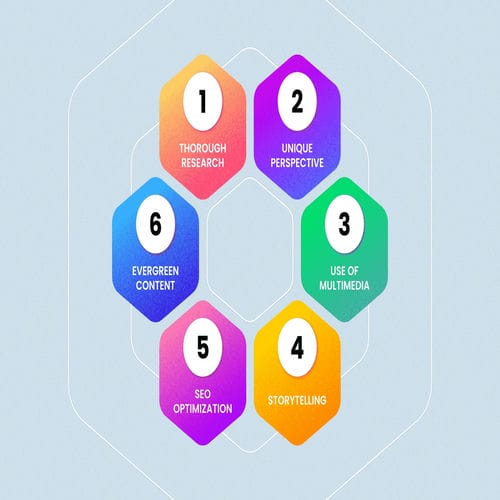Are you struggling to get your blog noticed by search engines? Are you also feeling trapped in the vast landscape of how to optimize blog for search engines?
Optimizing your blog for search engines might be the game-changer you need. In today’s digital age, simply writing great content isn’t enough. You need to make sure your blog stands out to both readers and search engines.
But how do you ensure your blog ranks high on search engine results pages (SERPs)? This comprehensive guide will walk you through the essential steps to optimize your blog for search engines, from keyword research to technical SEO.
We’ll break down the process into manageable tasks, so whether you’re a beginner or looking to refine your SEO strategy, you’ll find actionable insights here.
By the end of this article, you’ll have a clear understanding of how to make your blog more visible and attractive to search engines, ultimately driving more organic traffic to your site.
Ready to dive in? You’ll learn how to turn your blog into a powerful tool that not only engages your audience but also ranks high on search engines. Let’s get started on the journey to mastering blog optimization!
How to Optimize Blog for Search Engines?
1. Keyword Research
Keyword research serves as the cornerstone of any effective SEO strategy. It involves identifying the specific terms and phrases that your target audience is using when searching for information related to your blog’s topic.
By understanding and leveraging these keywords, you can significantly improve your blog’s visibility and attract relevant traffic.
2. Why Keyword Research Matters?
Effective keyword research provides invaluable insights into the language and intent of your audience. It allows you to understand their needs, preferences, and pain points, enabling you to tailor your content to meet their expectations.
By incorporating relevant keywords into your blog posts, you increase the likelihood of your content appearing in search engine results pages (SERPs) when users conduct related searches.
3. Tools for Keyword Research
Numerous tools are available to assist you in conducting keyword research effectively. Platforms such as Google Keyword Planner, SEMrush, and Ahrefs offer valuable insights into search volume, competition, and related keywords.
These tools enable you to identify high-potential keywords that align with your blog’s content and objectives.
4. Choosing the Right Keywords
Selecting the right keywords is critical to the success of your SEO efforts. It requires a balance between relevance, search volume, and competition. Focus on identifying keywords that are closely aligned with your blog’s topics and are likely to attract your target audience.
Additionally, consider the competitiveness of each keyword and prioritize those where you have a realistic chance of ranking well.
Keyword research is a fundamental aspect of optimizing your blog for search engines. By understanding the importance of keyword research, utilizing the right tools, and selecting relevant keywords strategically, you can lay a solid foundation for your SEO strategy.
Stay tuned as we delve deeper into other essential aspects of optimizing your blog for improved search engine visibility and traffic.
Must Read:
Crafting and Optimizing High-Quality Content
1. Content Creation and Optimization
Creating high-quality, valuable content is essential for engaging your audience and attracting organic traffic to your blog. We’ll explore the key principles of content creation and optimization to ensure your blog stands out in the crowded online landscape.
2. Importance of High-Quality Content
High-quality content serves as the foundation of a successful blog. It not only provides value to your audience but also establishes your authority and credibility in your niche.
By consistently delivering informative, well-researched content, you can build trust with your readers and encourage them to return for more.
3. Crafting Compelling Titles and Meta Descriptions
Effective titles and meta descriptions play a crucial role in attracting clicks from search engine results pages (SERPs). Your title should accurately reflect the content of your blog post while also being engaging and click-worthy.
Similarly, your meta description should provide a concise summary of your post, encouraging users to click through to read more.
4. Using Keywords Naturally Within the Content
While incorporating keywords into your content is important for SEO, it’s essential to do so in a natural and organic manner. Avoid keyword stuffing, which can detract from the readability and user experience of your content.
Instead, focus on seamlessly integrating keywords into your writing while maintaining a conversational tone.
5. Implementing Header Tags and Internal Links
Properly formatting your content with header tags (H1, H2, H3, etc.) helps search engines understand the structure and hierarchy of your content. Additionally, incorporating internal links to other relevant posts on your blog can improve navigation and encourage readers to explore more of your content.

Mastering On-Page SEO Techniques
1. On-Page SEO
On-page SEO plays a crucial role in ensuring that your blog ranks well in search engine results pages (SERPs). We’ll explore the essential on-page SEO techniques that you can implement to improve your blog’s visibility and attract more organic traffic.
2. Optimizing Images with Alt Text
Optimizing images with descriptive alt text not only improves accessibility for visually impaired users but also provides valuable context for search engines. When adding alt text to your images, be sure to include relevant keywords that accurately describe the content of the image and align with the overall theme of your blog post.
3. Using Descriptive URLs
Creating descriptive URLs that reflect the content of your blog post can help improve your blog’s visibility in search engine results.
Avoid using generic or randomly generated URLs and instead opt for concise, descriptive URLs that include relevant keywords. This not only enhances the user experience but also provides additional context for search engines.
4. Ensuring Mobile-Friendliness
With an increasing number of users accessing the internet via mobile devices, ensuring that your blog is mobile-friendly is paramount. Responsive design techniques allow your blog to adapt seamlessly to various screen sizes and devices, providing a positive user experience regardless of the device used.
5. Improving Site Speed
Site speed is a critical factor that can impact both user experience and search engine rankings. Slow-loading websites frustrate users and are penalized by search engines. Utilize tools such as Google PageSpeed Insights to identify areas for improvement and optimize your blog’s performance for faster load times.
Trending topics:
Implementing Technical SEO Best Practices
1. Technical SEO
Technical SEO involves optimizing the backend structure and elements of your website to improve its visibility and performance in search engine results pages (SERPs).
We’ll explore the essential technical SEO best practices that you can implement to ensure that your blog is effectively crawled, indexed, and ranked by search engines.
2. Creating and Submitting an XML Sitemap
An XML sitemap is a file that lists all the pages of your website, helping search engines understand its structure and prioritize crawling. By creating and submitting an XML sitemap to search engines such as Google, you can ensure that all of your blog’s pages are discovered and indexed efficiently.
3. Configuring the Robots.txt File
The robots.txt file instructs search engine crawlers on which pages of your website to crawl and index. Properly configuring your robots.txt file can help prevent search engines from indexing sensitive or irrelevant pages, thereby improving the overall crawl efficiency of your blog.
4. Prevent Duplicate Content Issues
Duplicate content can harm your blog’s search engine rankings. Canonical tags are HTML elements that specify the preferred version of a webpage, helping search engines identify and consolidate duplicate content.
By implementing canonical tags correctly, you can avoid duplicate content issues and ensure that your blog’s content is properly indexed and ranked.
5. Implementing Schema Markup for Enhanced Search Results
Schema markup is a structured data markup language that helps search engines understand the content of your website better.
By implementing schema markup for your blog’s content, such as articles, reviews, and recipes, you can enhance your search engine listings with rich snippets, increasing click-through rates and visibility in SERPs.
Implementing technical SEO best practices is crucial for optimizing your blog’s visibility and performance in search engine results pages.
By creating and submitting an XML sitemap, configuring the robots.txt file, using canonical tags to prevent duplicate content issues, and implementing schema markup for enhanced search results, you can ensure that your blog is effectively crawled, indexed, and ranked by search engines.

Enhancing User Experience and Engagement
1. User Experience and Engagement
User experience (UX) and engagement are critical factors that influence how visitors interact with your blog. We’ll delve into the importance of providing a seamless user experience and strategies for fostering engagement with your audience.
2. Importance of a Good User Experience
A good user experience is essential for retaining visitors and encouraging them to explore your blog further. A well-designed and easy-to-navigate website enhances user satisfaction and reduces bounce rates, signaling to search engines that your content is valuable and relevant to users’ needs.
3. Enhancing Readability and Accessibility
Improving readability and accessibility ensures that your content is accessible to all users, regardless of their device or ability. Utilize short paragraphs, bullet points, and clear headings to break up content and make it easier to digest. Additionally, provide descriptive alt text for images to assist visually impaired users and improve accessibility.
4. Encouraging Comments and Interactions
Encouraging comments and interactions fosters a sense of community and engagement with your audience. Prompt visitors to leave comments by asking questions, soliciting feedback, or inviting them to share their thoughts and experiences related to your blog post topics. Responding to comments promptly and engaging in discussions further enhances user engagement.
5. Adding Social Sharing Buttons
Adding social sharing buttons makes it easy for visitors to share your content with their social networks, expanding your blog’s reach and visibility. Place social sharing buttons prominently on your blog posts to encourage readers to share interesting or valuable content with their friends and followers.

Regular Monitoring and Updating
1. Regular Monitoring and Updating
Regular monitoring and updating are essential practices for maintaining the effectiveness of your SEO strategy over time. We’ll discuss the importance of monitoring your blog’s performance and strategies for keeping your content fresh and relevant.
2. Using Google Analytics and Google Search Console
Google Analytics and Google Search Console are invaluable tools for monitoring your blog’s performance and identifying areas for improvement. Track key metrics such as traffic, user behavior, and search engine rankings to gain insights into how your content is performing and where optimizations are needed.
3. Tracking Traffic and User Behaviour
Analyzing traffic and user behavior data allows you to understand how visitors are interacting with your blog and identify opportunities for optimization. Monitor metrics such as page views, bounce rates, and time on page to assess the effectiveness of your content and identify areas for improvement.
4. Identifying and Fixing SEO Issues
Regularly check Google Search Console for any SEO issues that may be affecting your blog’s performance. Address issues such as crawl errors, indexing problems, and mobile usability issues promptly to ensure that your blog remains accessible and visible to search engines.
5. Updating Old Blog Posts
Updating old blog posts with fresh content and relevant information helps keep your blog current and relevant to your audience. Add new insights, statistics, or examples to existing posts, and refresh outdated information to maintain the accuracy and usefulness of your content.
Conclusion
Optimizing your blog for search engines is essential for increasing visibility and attracting organic traffic. By implementing keyword research, creating high-quality content, and mastering on-page and technical SEO techniques, you can elevate your blog’s performance in search engine results pages. Remember, SEO is an ongoing process, requiring regular monitoring and updates to stay competitive.
Ready to take your blog to the next level? Explore our comprehensive SEO training courses at Devtrain.co and equip yourself with the skills needed to succeed in the ever-evolving world of search engine optimization.




binance referal code
Can you be more specific about the content of your article? After reading it, I still have some doubts. Hope you can help me.